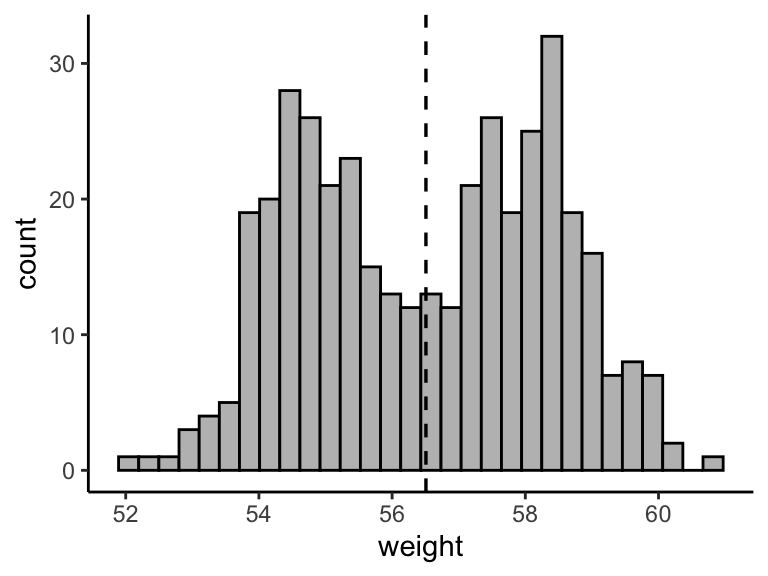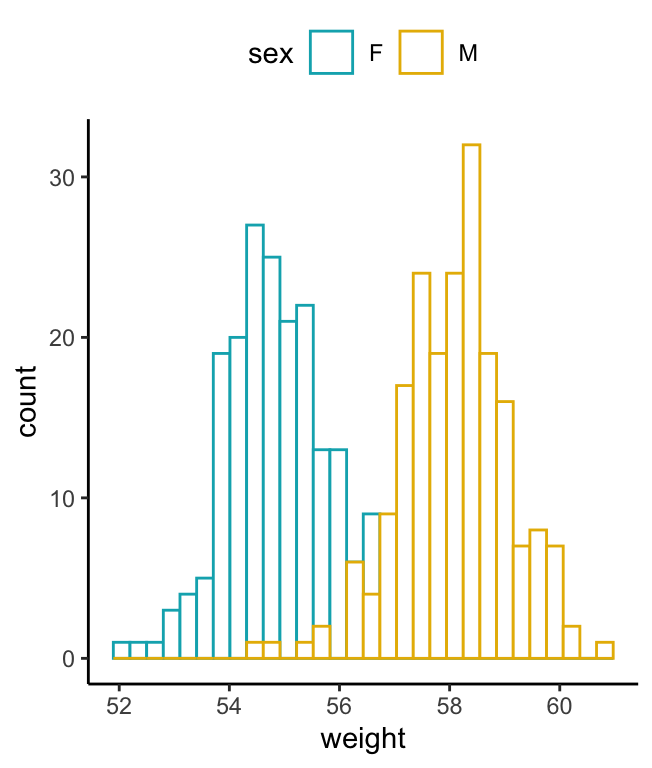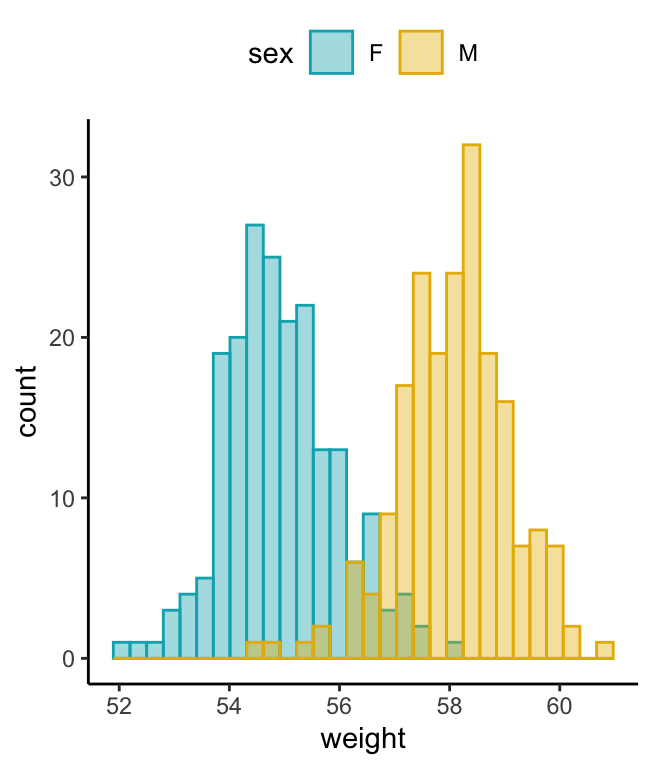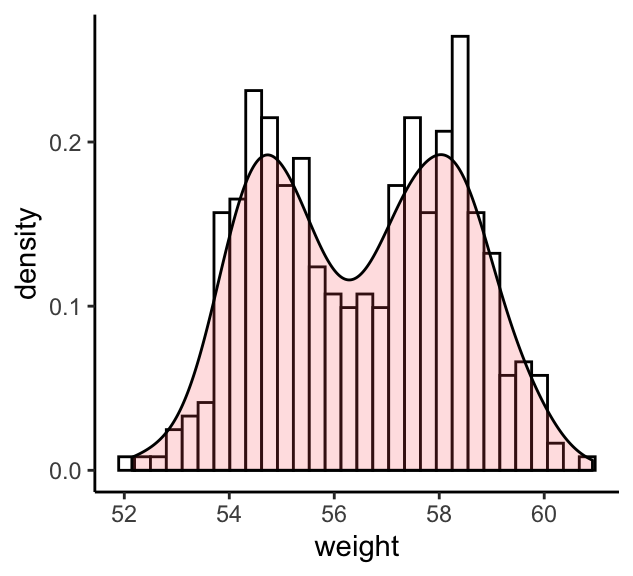Themes in R Histogram With Continuous Fill
GGPlot Histogram
A histogram plot is an alternative to Density plot for visualizing the distribution of a continuous variable. This chart represents the distribution of a continuous variable by dividing into bins and counting the number of observations in each bin.
This article describes how to create Histogram plots using the ggplot2 R package.
Contents:
- Key R functions
- Data preparation
- Loading required R package
- Basic histogram plots
- Change color by groups
- Combine histogram and density plots
- Conclusion
Related Book
GGPlot2 Essentials for Great Data Visualization in R
Key R functions
- Key function:
geom_histgram()(for density plots). - Key arguments to customize the plots:
-
color, size, linetype: change the line color, size and type, respectively -
fill: change the areas fill color (for bar plots, histograms and density plots) -
alpha: create a semi-transparent color.
-
Data preparation
Create some data (wdata) containing the weights by sex (M for male; F for female):
set.seed(1234) wdata = data.frame( sex = factor(rep(c("F", "M"), each=200)), weight = c(rnorm(200, 55), rnorm(200, 58)) ) head(wdata, 4) ## sex weight ## 1 F 53.8 ## 2 F 55.3 ## 3 F 56.1 ## 4 F 52.7 Compute the mean weight by sex using the dplyr package. First, the data is grouped by sex and then summarized by computing the mean weight by groups. The operator %>% is used to combine multiple operations:
library("dplyr") mu <- wdata %>% group_by(sex) %>% summarise(grp.mean = mean(weight)) mu ## # A tibble: 2 x 2 ## sex grp.mean ## <fct> <dbl> ## 1 F 54.9 ## 2 M 58.1 Loading required R package
Load the ggplot2 package and set the default theme to theme_classic() with the legend at the top of the plot:
library(ggplot2) theme_set( theme_classic() + theme(legend.position = "top") ) Basic histogram plots
We start by creating a plot, named a, that we'll finish in the next section by adding a layer using the function geom_histogram().
a <- ggplot(wdata, aes(x = weight)) The following R code creates some basic density plots with a vertical line corresponding to the mean value of the weight variable (geom_vline()):
# Basic density plots a + geom_histogram(bins = 30, color = "black", fill = "gray") + geom_vline(aes(xintercept = mean(weight)), linetype = "dashed", size = 0.6) 
Note that, by default:
- By default,
geom_histogram()uses 30 bins - this might not be good default. You can change the number of bins (e.g.: bins = 50) or the bin width (e.g.: binwidth = 0.5) - The y axis corresponds to the count of weight values. If you want to change the plot in order to have the density on y axis, specify the argument
y = ..density..inaes().
Change color by groups
The following R code will change the histogram plot line and fill color by groups. The functions scale_color_manual() and scale_fill_manual() are used to specify custom colors for each group.
We'll proceed as follow:
- Change areas fill and add line color by groups (sex)
- Add vertical mean lines using
geom_vline(). Data:mu, which contains the mean values of weights by sex (computed in the previous section). - Change color manually:
- use
scale_color_manual()orscale_colour_manual()for changing line color - use
scale_fill_manual()for changing area fill colors.
- use
- Adjust the position of histogram bars by using the argument
position. Allowed values: "identity", "stack", "dodge". Default value is "stack".
# Change line color by sex a + geom_histogram(aes(color = sex), fill = "white", position = "identity") + scale_color_manual(values = c("#00AFBB", "#E7B800")) # change fill and outline color manually a + geom_histogram(aes(color = sex, fill = sex), alpha = 0.4, position = "identity") + scale_fill_manual(values = c("#00AFBB", "#E7B800")) + scale_color_manual(values = c("#00AFBB", "#E7B800")) 

Combine histogram and density plots
- Plot histogram with density values on y-axis (instead of count values).
- Add density plot with transparent density plot
# Histogram with density plot a + geom_histogram(aes(y = stat(density)), colour="black", fill="white") + geom_density(alpha = 0.2, fill = "#FF6666") # Color by groups a + geom_histogram(aes(y = stat(density), color = sex), fill = "white",position = "identity")+ geom_density(aes(color = sex), size = 1) + scale_color_manual(values = c("#868686FF", "#EFC000FF")) 

Conclusion
This article describes how to create histogram plots using the ggplot2 package.
Recommended for you
This section contains best data science and self-development resources to help you on your path.
Version:  Français
Français
mccloudmakenhaved1960.blogspot.com
Source: https://www.datanovia.com/en/lessons/ggplot-histogram/
0 Response to "Themes in R Histogram With Continuous Fill"
Post a Comment